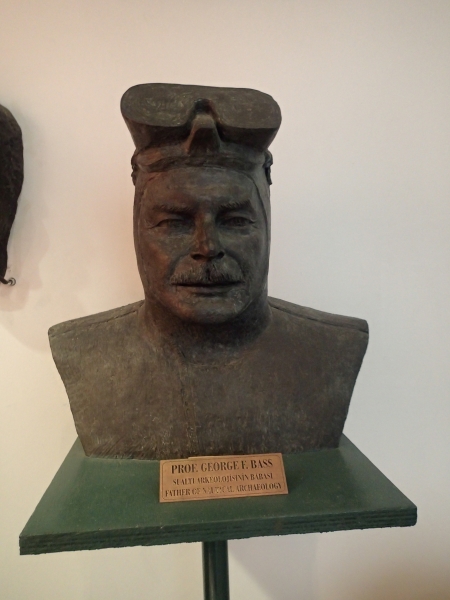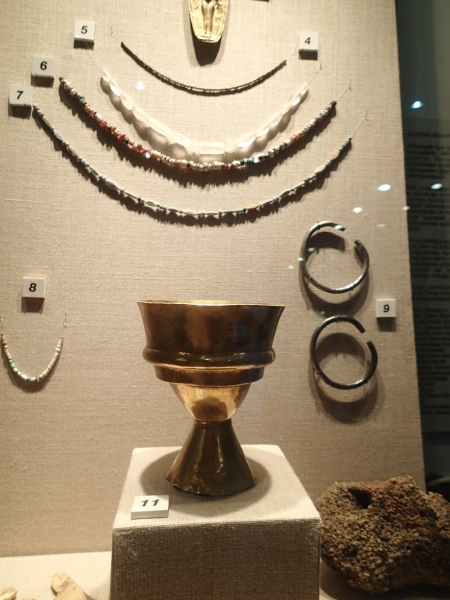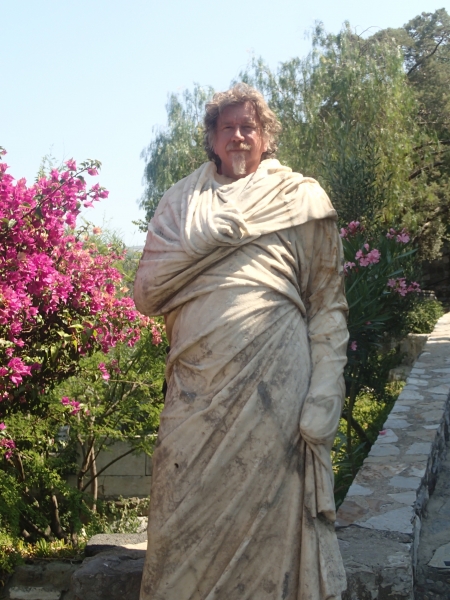After our “Village Breakfast” at the Kos Hotel, we headed off for the Museum…we stopped off at the reception to get a business card….so we had the address for our return to we needed it…. and our host kindly organised a driver for us free of charge to take us there…which was very unexpected.
We used our Museum Passes to get in free. The Bodrum Museum of Underwater Archaeology is housed in the Bodrum Castle of The Knights of St. John and its not a dusty collection of lifeless relics, it is very original, creative and interesting. It covers the history through exhibits that take you back in time into the worlds of ancient mariners who sailed to meet their destiny shipwrecked on Anatolian shores or to the medieval Age of Knights who built this castle from stones that once were part of one of the Seven Wonders of the ancient World: The Mausoleum of Halicarnasus.
Finds from The Yassıada shipwreck, found off the coast of the Bodrum Peninsula, are on show and there is a model of the wreck that you can walk over. In the ship, dated to the 6th century AD, there was a cargo of many amphorae that were filled with wine. During excavations, kitchen utensils, the remains of food and equipment of the vessel were salvaged. All the iron original artefacts that were salvaged were so badly corroded by the effects of the salt water that their character could not be determined. The most interesting find was the plaque with a pigs face on it and bearing and engraving of the name of the ship’s captain, George. The ship is displayed in what was once used as a chapel by the knights and later in the Ottoman period a Mosque.
The “Glass Shipwreck”, named because of the numerous glass items that were recovered, sank in the 11th century after striking rocks near the port of Serçe. The shipwreck was lying in 32 metres, and was excavated between 1977 and 1979 by Professor George Bass, who found it to be in a fairly good condition. After clearing the cargo of blocks of commercial glass, the belongings of a merchant who used to travel freely between the Islamic states and Byzantine were found. While the bulk glass was being loaded to be melted and shaped, the new products were sold in different ports. Many pieces from the early Islamic period, such as swords, cups with holes to drain and the checker pieces were found. With the help of the discoveries, it was established the ship sank around 1025.
Behind the Italian Tower, houses the sarcophagus, skeleton and private belongings of the Carian Princess Ada (Island) of the Henkatomnos dynasty.The identification of the skeleton, unearthed while foundations were being dug in 1989, was proven to be the Carian princess. A reconstruction of the flesh made in England based on the skeleton gave an indication that the face had similarities to a portrait of Princess Ada that was found in Priene, the jewellery also recovered has a Persian influence, while anthropologic studies showing that she had given birth multiple times made the argument even stronger. This woman, who died when she was 44, had had her jewellery, a drinking cup and gold embriodered clothing placed in her burial chamber. The princess died around 330 BC and, along with her skeleton, the skeleton of a mouse that had got in before the top of her tomb was shut with the large stone was also recovered. You can see the DVD of the recovering of the finds, a chronology of her family tree and a plaster copy of the face of the princess that was developed in England where the skull of the princess had been sent to the British Museum from Priene. Whilst photographing her jewellery I accidentally set off an alarm that scared me….but it went off many times whilst I was there…..as it was linked to some seats people kept sitting on!
They close the exhibits at lunch time so around 12.00 we went and had an icecream (to cool down) and a drink and waited (Vince had a little lay down – see pic) until 1.00 to see the final 3 exhibits.
They were worth the wait! Professor George Bass is recognized as one of the early pioneers of underwater archaeology along with Peter Throckmorton, Honor Frost (and others). Bass was the director of the first archaeological expedition to entirely excavate an ancient shipwreck: Cape Gelidonva in 1960 and since then he has excavated shipwrecks of the Bronze Age, Classical Age and Byzantine. He worked for the Uni of Pennsylvania and the Texas A&M Uni and many of his amazing finds were exhibited throughout the Museum. In 1973 he founded the Institute of Nautical Archaeology and there is a branch in Bodrum. His work and findings have thrown new light on things like the dating of Homer’s Odyssey, chronologies of Egyptian dynasties and Helladic cultures…..it was fascinating to hear about him in both TV displays, static displays and our audio guides (15TL each).
The Exhibition Hall of Bronze Age Wrecks: to the east of the castle, in front of the British Tower – home of the Knight of St John, pieces salvaged from the oldest shipwrecks found in Turkish waters are displayed. The şeytanderesi Batağı (The Streamlet of Satan Wreck) was found in a crevice in the Gulf of Gökova and the finds consist of cups and jars. While there was no information on the ship itself, the pieces recovered were dated to the 16th century BC and believed to come from the city of Keramos, named for its pottery production centre. The second wreck in the hall is the famous Gelindonya Point Wreck, which was carrying bronze plates, an anvil and shipping and agricultural tools when it sank.
The Gelindonya Wreck is believed to be the oldest shipwreck in Turkey. The vessel started its journey from the Caananite state in Palestine and according, to Egyptian records, was a merchant ship. In the vessel, which was dated to the 13th century BC, there was a cup from the Mycenaean world (discovered by Bass). Another wreck on display is that from Kaş-Uluburun. Most of the pieces are merchandise that came from Egypt, Caanan and Cyprus. The items of ivory and ebony in the cargo section are of African origin. There were copper blocks from Cyprus, and Caananite amphorae that were filled with Arab mastic incense. Moreover, many extraordinary pieces such as the golden seal belonging to the Egyptian Queen Nerfertiti that was sold to a scrap collector, an ivory fringed wooden book, a statue of the goddess of Caanan that protected ships and Egyptian blue glass blocks were recovered. With the study of the rings in the wood of the ship the vessel was dated to around 1316 BC.
It was a fascinating day and we spent around 4 hours in all. We then caught a Taxi (15TL) to Oasis….the first shopping centre in Bodrum….and we picked up a couple of things we needed and also took the chance to see the new Jurassic World movie…in air-conditioned comfort.
We walked back to our hotel as it was around 7.00pm by then and we just ordered a couple of hamburgers for dinner from the bar as we needed to pack and get organised for an early start tomorrow. We need to get to Ankara (at least 700km) by tomorrow evening as we have to get our Iranian visas first thing on Friday Morning. So an early night for us….subject to the DOOF DOOF music of course!















